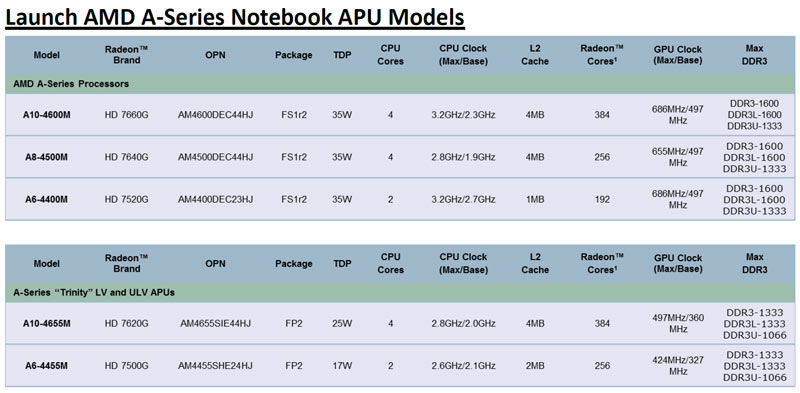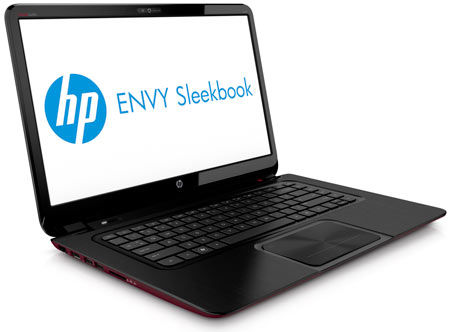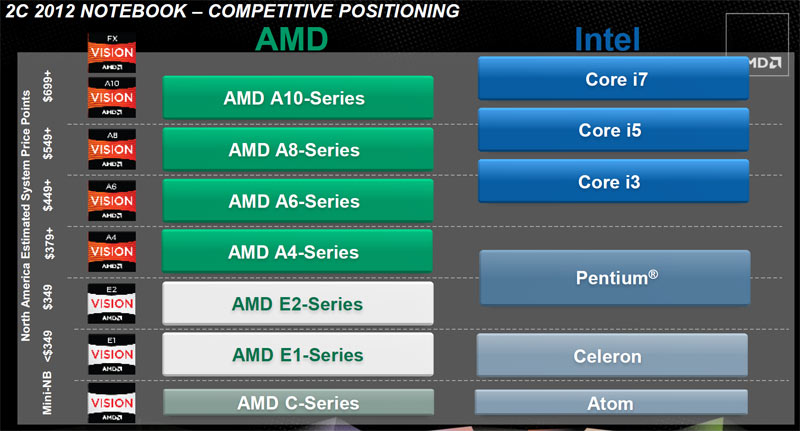AMD A10-4600M Review: Mobile Trinity Gets Tested
AMD steps up to the plate with an all-new processor. Armed with the updated Piledriver CPU core and VLIW4 graphics architecture, the Trinity APU represents an impressive improvement over the Llano generation. But can it stand up to Intel's best efforts?
Products And Platforms
As it did with Llano, AMD is selling Trinity in mobile form first, and in desktops later. Because the APU is a best-fit in the mobile space, this gives AMD an opportunity to show it off where it most belongs.
The laptop models require the new FS1r2 socket (or FP2 interface, for the low-voltage models), though this is going to be inconsequential for most notebook owners who don’t upgrade their processors. Unfortunately, an interface update is much more of a concern on the desktop, since Trinity requires a Socket FM2-based motherboard. Owners of Socket FM1 platforms must retire their boards after just a single generation. Ouch.
So far, we only have information on the first A6, A8, and A10 mobile models:

As you can see, the Trinity-based A8s and A10s are quad-core designs, while the A6s are dual-core implementations. This is both surprising and confusing, since Llano-based A6s come equipped with four cores.
The A10 models sport graphics engines with 384 cores, while the A8s are armed with 256 shaders. The A6 either includes 256 or 192 shaders, depending on whether you’re looking at a standard 35 W model or the low-power 17 W APU.
Speaking of low power, let’s talk about those LV and ULV APUs. At 25 W for the A10-4655M and 17 W for the A6-4455M, we expect to see both chips used in AMD’s new ”Ultrathin” initiative, which counters Intel’s Ultrabook and Apple’s MacBbook Air. AMD expects the first APU-powered Ultrathins to arrive from OEMs within a month or so, measuring between 18 and 22 mm thick.

Unfortunately, we don’t have any information on the Trinity-based desktop models. AMD tells us that when they land, there will be 65 and 100 W variants, and that CPU clock rates will range between 2.0 and 3.8 GHz, while graphics varies from 424 and 800 MHz. AMD also mentions an APU called the A10-5800K in its press material. So, it’s probably that that’s the flagship with a 100 W TDP, a 3.8 GHz core clock, and an 800 MHz GPU clock. The K designator indicates an unlocked multiplier, too.
Stay On the Cutting Edge: Get the Tom's Hardware Newsletter
Get Tom's Hardware's best news and in-depth reviews, straight to your inbox.
Positioning and Pricing

The preceding chart shows what AMD suggests that notebooks armed with Trinity-based APUs will cost in North America. While it looks like AMD is being optimistic about competitive product positioning, based on processor performance, it may be underselling the potential of its graphics solution compared to Intel’s Sandy Bridge architecture (though this will change once Intel purges second-gen Core chips from the channel and starts shipping notebooks with third-gen Core i5s).
Dual Graphics
Dual Graphics, the ability to team an APU’s graphics core with a discrete GPU, is enabled on Trinity-based chips, as it was in the generation prior. AMD isn’t limiting interoperability to similar architectures; you can combine the APU’s VLIW4 design with add-in models based on the older VLIW5 implementation, including rebranded Radeon HD 7400 to 7600 GPUs.

Those aren’t the only possible Dual Graphics combinations—just the ones that AMD thinks make the most sense.
Current page: Products And Platforms
Prev Page All Together Now: The Trinity APU Next Page Test Setup And Benchmarks-
Recently Charlie at semiaccurate (a massive amd fanboy) hinting an upcoming apple products, then I saw an article in thg that tells an upcoming mbp will using retina display... 15 inch retina will require huge gpu horsepower, my wild guess is mbp will use trinity as it's CPU.Reply
-
Based on this, gaming is much better than old i5, but everything else including application performance is still better on the old Sandy architecture. I'm not really sure why I would buy a Trinity other than for a casual gaming laptop. Unfortunately, budget says that my laptops have to be used for business first, play time later.Reply
-
beenthere Nice to see that Trinity and AMD have delivered the goods. I want a Trinity powered Ultrathin. Intel can stick their crap where the Sun don't shine.Reply
BTW, Charlie @ SemiAccurate is not an AMD fanbois IME. He just calls it like it is. Reality bites sometimes be it Nvidia, AMD or Intel's problems. Denial never changes reality. It is what it is. -
cleeve duckwithnukesWhere is the Intel HD 4000 vs. AMD Trinity comparison? Lazy reviewing at its finest.Reply
A10-4600M laptops will be int eh $600-$700 neighborhood, and we're still waiting for Ivy bridge Core i5 to arrive in this price range.
We go over this. We also talk about how we'll do a follow up as soon as an appropriate product is available.
You need to read for it to make sense.
-
FlippyFlap, Apple doesn't use AMD and an HD4000 can power a retina display. I'm sure Apple has worked with Intel engineers to get the drivers right for retina displays which is HD4000's problem. HD4000 is still lacking in terms of driver support (one can see that from the OpenCL benches around the net where only 1/2 get acclerated on HD4000). When the drivers work right, there isn't much difference between Ivy and Trinity.Reply
-
I agree with Cleeve and I personally hate comparing a reference system to a selling system anyway. Review 2 actual selling systems with similar parts and that gives you the benchmark.Reply
-
DRosencraft This looks like a very nice effort from AMD. I really, really need to replace my notebook. It's a six year old Toshiba Satelite with an AMD 1.9 GHz Turion 64 X2 with intergrated X2100 graphics.... yeah. Ancient now, I know. I've been trying to figure out a sweet spot in power since my needs are kind of complex. Typically I don't need it to do much more than handle MSOffice and web surfing. But I also tend to use it for video gaming when am interesting game comes around and some work in PaintShop when I'm out of the house, or don't feel like sitting at my desktop. This may be a little closer to what I'd like. It would be nice to get a notebook that combines this with a really good discrete card (sort of like how some MacBook Pros have their dual graphics setup). Nevertheless, Trinity looks to be just about enough power and performance, but the question is price. If tradition holds, it should be a good price competitor with Intel, which is the most important part, otherwise I'd just buy a core I7 already.Reply
In a related question, does Trinity's details and specs lead to any conclusions about what Piledriver desktop processors will be like? -
neoverdugo So this means that AMD can kick Intel's ass in the gpu department for the moment while AMD suffers greatly in the CPU portion of the apu battle. Didn't I said before that Intel is trying to make an (proprietary) Intel only PC with no third party strings attached? We all know that there is no competition in the CPU battle when it comes to Intel. Still, i would like to see that the morons of intel to drop the price of their hardware for once and for all and drop ridiculously low end hardware out of production.Reply -
dgingeri No WoW benchmarks this time? I was wondering if this might make a good laptop for WoW, but you guys failed me. :(Reply